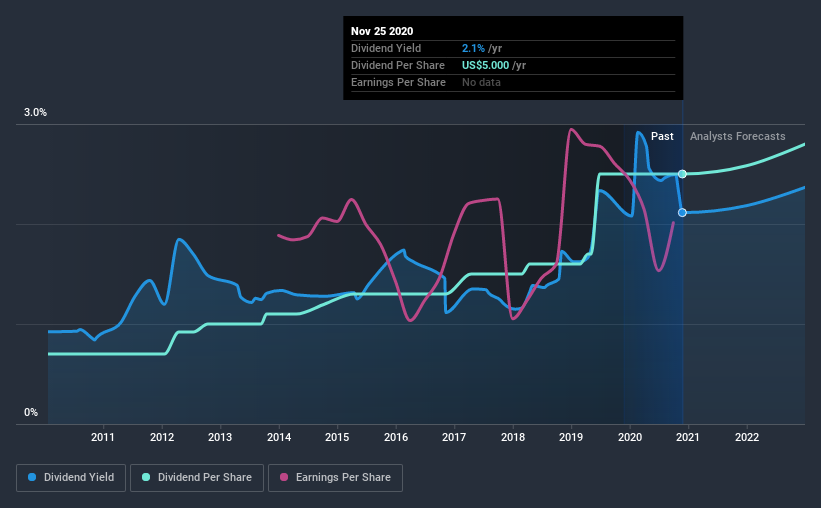The Goldman Sachs Group, Inc. (NYSE:GS) Will Pay A US$1.25 Dividend In Four Days
The Goldman Sachs Group, Inc. (NYSE:GS) is about to trade ex-dividend in the next 4 days. Investors can purchase shares before the 1st of December in order to be eligible for this dividend, which will be paid on the 30th of December.
Goldman Sachs Group's next dividend payment will be US$1.25 per share. Last year, in total, the company distributed US$5.00 to shareholders. Looking at the last 12 months of distributions, Goldman Sachs Group has a trailing yield of approximately 2.1% on its current stock price of $236.54. Dividends are an important source of income to many shareholders, but the health of the business is crucial to maintaining those dividends. We need to see whether the dividend is covered by earnings and if it's growing.
View our latest analysis for Goldman Sachs Group
Dividends are typically paid from company earnings. If a company pays more in dividends than it earned in profit, then the dividend could be unsustainable. Goldman Sachs Group paid out a comfortable 29% of its profit last year.
Companies that pay out less in dividends than they earn in profits generally have more sustainable dividends. The lower the payout ratio, the more wiggle room the business has before it could be forced to cut the dividend.
Click here to see the company's payout ratio, plus analyst estimates of its future dividends.
Have Earnings And Dividends Been Growing?
Stocks with flat earnings can still be attractive dividend payers, but it is important to be more conservative with your approach and demand a greater margin for safety when it comes to dividend sustainability. If earnings decline and the company is forced to cut its dividend, investors could watch the value of their investment go up in smoke. With that in mind, we're not enthused to see that Goldman Sachs Group's earnings per share have remained effectively flat over the past five years. It's better than seeing them drop, certainly, but over the long term, all of the best dividend stocks are able to meaningfully grow their earnings per share.
Another key way to measure a company's dividend prospects is by measuring its historical rate of dividend growth. Since the start of our data, 10 years ago, Goldman Sachs Group has lifted its dividend by approximately 14% a year on average.
To Sum It Up
Is Goldman Sachs Group an attractive dividend stock, or better left on the shelf? Goldman Sachs Group's earnings per share have not grown at all in recent years, although we like that it is paying out a low percentage of its earnings. At best we would put it on a watch-list to see if business conditions improve, as it doesn't look like a clear opportunity right now.
However if you're still interested in Goldman Sachs Group as a potential investment, you should definitely consider some of the risks involved with Goldman Sachs Group. Our analysis shows 3 warning signs for Goldman Sachs Group that we strongly recommend you have a look at before investing in the company.
If you're in the market for dividend stocks, we recommend checking our list of top dividend stocks with a greater than 2% yield and an upcoming dividend.
This article by Simply Wall St is general in nature. It does not constitute a recommendation to buy or sell any stock, and does not take account of your objectives, or your financial situation. We aim to bring you long-term focused analysis driven by fundamental data. Note that our analysis may not factor in the latest price-sensitive company announcements or qualitative material. Simply Wall St has no position in any stocks mentioned.
Have feedback on this article? Concerned about the content? Get in touch with us directly. Alternatively, email editorial-team@simplywallst.com.

 Yahoo Finance
Yahoo Finance 
